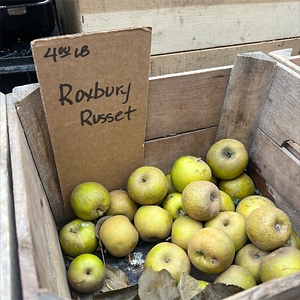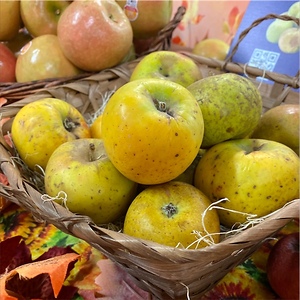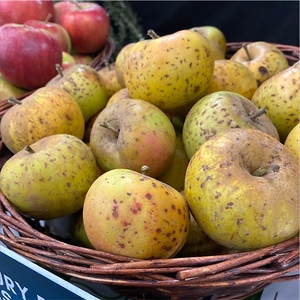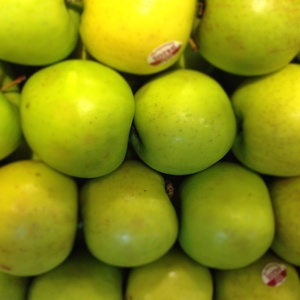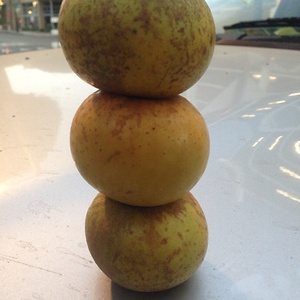

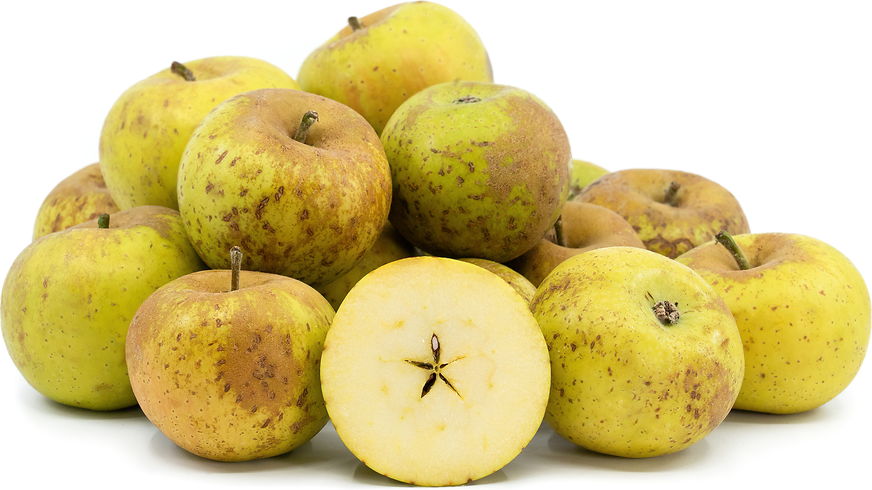
Roxbury Russet Apples
Estimated Inventory, lb : 0
Description/Taste
Roxbury Russet apples are a medium to large varietal and have a round to ovate shape with flattened shoulders, a curved center, and a narrow base. The variety often showcases ribbing, creating angular faces across the apple’s surface, and the stems are long, slender, woody, and fibrous. The skin is semi-thin, textured, and taut, covered in speckled patches of rough, brown russet. The russet can be solid or flecked and is sometimes raised, giving the surface a blotchy appearance. The skin also ripens from green to golden yellow, flushed with a muted bronze-red blush on the sides with direct sun exposure. Underneath the surface, the yellow to ivory flesh is firm, dense, coarse, and aqueous with a granular, crisp, and crumbly consistency. The flesh also encases a central core filled with tiny black-brown seeds. Roxbury Russet apples have high sugar mixed with acidity, creating a rich, sweet, and tart flavor. The apple is known for its brisk complexity and is said to contain nutty, spice-filled, and fruity nuances with citrus, persimmon, honey, and vanilla undertones.
Seasons/Availability
Roxbury Russet apples are harvested in the fall through early winter and can be stored through the spring.
Current Facts
Roxbury Russet apples, botanically classified as Malus domestica, are an American variety belonging to the Rosaceae family. The late-season heirloom is considered to be the oldest apple variety native to North America and was discovered growing as a chance seedling in the mid-17th century. Roxbury Russet apples grow on deciduous trees reaching 3 to 5 meters in height and were favored by growers for their hardiness, reliability, and resistance to scab, fire blight, and cedar apple rust. After their discovery, Roxbury Russet apples were famous throughout the northeastern United States for the fruit’s ability to be stored for extended periods, staying fresh throughout the winter. The variety is also known as Leather Coat for its rough, russeted skin and other regional names, including Boston Russet, Putnam Russet, Warren Russet, Shippen’s Russet, and Sylvan Russet apples. Roxbury Russet apples remained a prominent commercial cultivar throughout the 18th and early 19th centuries as an all-purpose apple for fresh and cooked culinary preparations and cider making. In the modern day, Roxbury Russet apples have become rare and are only found through preservation orchards, growing the variety as a novelty. The cultivar is not commercially produced and is only offered in limited quantities as a specialty apple through select fresh markets in the United States.
Nutritional Value
Roxbury Russet apples have not been studied for their nutritional properties. Like other apple cultivars, the variety is a source of fiber to regulate the digestive tract, vitamin C to strengthen the immune system, vitamin E to protect the cells against free radical damage, and calcium to build strong bones and teeth. The apples also provide vitamin K to assist in faster wound healing, iron to develop the protein hemoglobin for oxygen transport through the bloodstream, B vitamins to maintain overall health, potassium to balance fluid levels within the body, and other nutrients, including copper, manganese, phosphorus, zinc, and magnesium.
Applications
Roxbury Russet apples have a complex, sweet, tart, and spice-filled taste suited for fresh and cooked preparations. The variety is often classified as an all-purpose cultivar and is favored for its ability to be eaten directly off the tree. Roxbury Russet apples can be served on charcuterie boards, chopped into salads, or mixed into fruit medleys. The apples can also be sliced and layered in sandwiches, used as a topping over parfaits, porridge, pancakes, and toast, or dipped in nut butter or caramel as a snack. In addition to fresh preparations, Roxbury Russet apples hold their shape well and are incorporated into pies, cakes, muffins, crisps, crumbles, and tarts. The variety was popularly simmered into applesauce in the 18th century and was also wrapped in pastry and baked as a dessert. Beyond culinary preparations, Roxbury Russet apples were notably pressed into cider blends and were said to create a thick, nectar-like juice. Roxbury Russet apples pair well with spices such as cinnamon, nutmeg, ginger, nutmeg, and cardamom, maple syrup, vanilla, chocolate, and nuts such as pecans, walnuts, almonds, and pistachios. Whole, unwashed Roxbury Russet apples will keep for 3 to 5 months when stored in a cool, dry, and dark place such as a cellar or the refrigerator’s crisper drawer.
Ethnic/Cultural Info
The beginning of Roxbury Russet apples marked the end for their discoverer, Joseph Warren II. The variety was said to have been found in Warren’s orchard in the 1630s and significantly helped the family increase their income through the sale of the apple. The variety became so famous that it was sometimes called Warren Russet in honor of the founding family. The favor of Roxbury Russet apples was short-lived among the Warren family, as apples ultimately led to Joseph Warren’s demise. In 1755, Warren fell off a ladder while picking apples, breaking his neck and eventually perishing from injuries. It is unknown which apple he was harvesting, but many claim he was picking Roxbury Russet apples. Beyond the apples, the Warren family was also famous for Dr. Joseph Warren III, the son of the late Joseph Warren II. Dr. Joseph Warren III was an American physician and revolutionary leader recognized for his death at the Battle of Bunker Hill during the Revolutionary War.
Geography/History
Roxbury Russet apples are native to the United States and were discovered sometime before 1635. The variety’s parentage is unknown as pomologists believed it to have arisen as a chance seedling from a European apple cultivar. During this time, the community of Roxbury was a part of the Massachusetts Bay Colony, later to become part of Boston. Roxbury was known for its rocky soil, and apple trees thrived in this soil, allowing orchards to be widespread throughout the region. Roxbury Russet apples were first found growing as a chance seedling on the farm of Joseph Warren II, and the new apples were grafted and studied for possible cultivation. The variety expanded in cultivation as it was developed and became a popular multi-purpose commercial apple throughout the 18th and 19th centuries. In 1778, Thomas Jefferson planted Roxbury Russet apples at his home estate, Monticello, and referred to the variety as “russetings.” Roxbury Russet apples were notably sent to Connecticut and Marietta, Ohio, in the late 18th century and were grown at the well-known Putnam Nursery under the names Marietta Russet and Putnam Russet. Roxbury Russet apples were also sent to New York and cultivated in Chief Justice Shippen's orchard under the name Shippen’s Russet. In New York in 1905, Roxbury Russet apples were one of the most cultivated russet apple varieties. Despite their popularity throughout the 18th and early 19th centuries, Roxbury Russet apples eventually declined in production when russet varieties were exchanged for aesthetically pleasing cultivars. The invention of refrigeration also led to Roxbury’s decline, as long-storing varieties were no longer a necessity. Today, Roxbury Russet apples are a rare heirloom variety grown in limited quantities throughout the United States. The apples are found in the Northeast, the Midwest, the Pacific Northwest, and occasionally in coastal Southern California.



